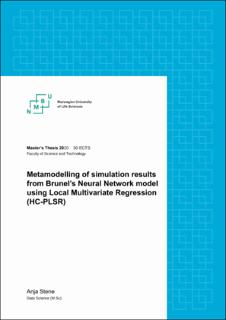| dc.description.abstract | In efforts of explaining biological system behavior, a common mean has been to use mathematical models. To model intricate biological systems does often require complex, non-linear and high-dimensional differential equation systems. This is especially the case in computational neuroscience, where models of the human brain and nervous system is at center for the mathematical models and theoretical analysis. The human brain consists of 100 billion neurons and 100 trillion synaptic connections, and the electrical activity in these neural networks (interconnected neurons) is determined by a wide range of factors [1] , thus modelling of such networks require a large number of parameters and state variables. In turn, highly complex models result in increased computational costs.
Existing techniques for parameter estimation and sensitivity analysis is often more suitable for low dimensional output space and does typically focus on one output variable at the time.
Statistical representation of models is an increasingly explored technique for prediction of input-output relations. Statistical emulations (also called metamodels) has shown ability to act as a parameter reduction technique, and thus reducing the computational costs. In addition to improving computational efficiency, it has also shown beneficial for serving as a basis for sensitivity analysis (the study of how the system input variations influence the output).
The aim of this paper is to explore the possibilities in using metamodelling on data generated by realistic deterministic dynamic models of complex biological systems, and to implement a specific strategy that has proven useful in other studies [2]. As a part of this, it is also a sub goal to contribute to the development of a robust metamodelling methodology capable of producing accurate predictive mappings which allows for extensive automation. This can then also serve as a tool for exploring of dataset by other scientists.
The content of this study can be summarized to contain an overview of some benefits of metamodelling, and a reflection upon modelling strategies for cultivating interdisciplinary understanding and collaboration across scientific fields. It will introduce a framework for applying regression methods to non-linear data. Specifically, a reasonably new regression method called Hierarchical Cluster based Partial Least Squares Regression (HC-PLSR) [2] is implemented and demonstrated. The hypothesis herein, is whether a strategy of local modelling (by separating data using clustering techniques) can account for non-linearities in the dataset, that a single regression (PLSR) model cannot. The HC-PLSR method has proven useful in other cases by improving performance due to local modelling strategies, and this has been demonstrated on different kinds of datasets. Thus, it was of interest to contribute to the exploration of this methodology by using a dataset generated from model simulation of a neuroscientific neural network design described by Brunel [3].
After this project, resulting content of the work consists of; 1) a framework for implementing and simulation of Brunel’s Model A [3] with parameters sampled from the AI-space (Asynchronous Irregular firing), 2) a single, global PLSR model implemented for performance comparing, 3) Implementation of HC-PLSR model variations for exploration of method performance on non-linear data. When inspecting the resulting dataset prepared for modeling experimentation, the relations between regressors (X) and responses (Y) was indeed non-linear, but not what could be described strong non-linearities.
The HC-PLSR local modelling did not outperform the PLSR regression method in all cases, however, it did have a general higher prediction accuracy (R2, MSE and MAE) when compared to a linear PLSR model. This was especially apparent when no interaction/higher order terms were included. This might indicate that the HC-PLSR does account for non-linearities in the data, but when the data is not strongly non-linear, it might be sufficient to use a polynomial PLSR model (by adding higher order terms and cross terms).
The work process has also demonstrated the need for a modular and generalized framework, because the HC-PLSR method can be optimized and tuned by a number of regression model parameters. Thus, a resulting framework (using python programming language) is shared [4], containing different model variations/combinations, with the purpose of making metamodelling accessible by utilizing a modular strategy. | en_US |

